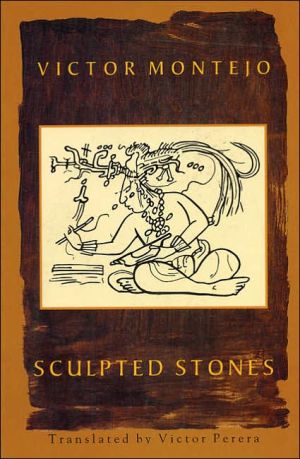Sculpted Stones (Piedas Labradas): Poems
The poems in Montejo's SCULPTED STONES give lyric expression to the feelings of exile and to the (sometimes comic) difficulties of living in a foreign culture. Throughout this book, Montejo extols the values of the Maya culture and denounces the Guatemalan government's attempts to destroy the Indian society. At times with tenderness, at times with humor, at times with scathing irony, Montejo examines nature, politics, and recorded history to get at the truths of the present and the past.\ \...
Search in google:
"Poems written between 1982-92 by the Guatemalan folklorist after leaving his country for the US. Themes include violence of war, exile, continuity with the past, and love for ...Library JournalIncorporating indigenous folklore motifs similar to The Bird Who Cleans the World (LJ 8/91), even resembling the flavor of Popol Vuh, the pre-Columbian holy scriptures, Montejo's poetic vision first evokes the absent Mayan culture ("the navel of the world"), whose titular stones are symbolically "still on our feet/vigilant/among the silken/cobwebs/of time." He then transfers these images into the second part, whose hallmark is nostalgia in exile ("I know my umbilical cord/is planted/there in the highlands/of Guatemala") as he longs for his homeland: "enchantment and poetry/the spring fiesta/in the waist of America." This good bilingual text marks the first publication for both texts. One only laments that the useful footnotes are not distributed equally in each version. Recommended.-Lawrence Olszewski, OCLC, Dublin, Ohio
\ Library JournalIncorporating indigenous folklore motifs similar to The Bird Who Cleans the World (LJ 8/91), even resembling the flavor of Popol Vuh, the pre-Columbian holy scriptures, Montejo's poetic vision first evokes the absent Mayan culture ("the navel of the world"), whose titular stones are symbolically "still on our feet/vigilant/among the silken/cobwebs/of time." He then transfers these images into the second part, whose hallmark is nostalgia in exile ("I know my umbilical cord/is planted/there in the highlands/of Guatemala") as he longs for his homeland: "enchantment and poetry/the spring fiesta/in the waist of America." This good bilingual text marks the first publication for both texts. One only laments that the useful footnotes are not distributed equally in each version. Recommended.-Lawrence Olszewski, OCLC, Dublin, Ohio\ \
